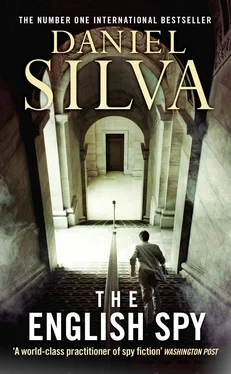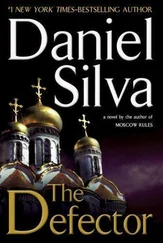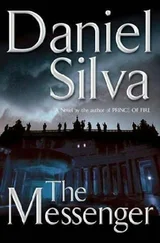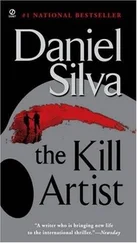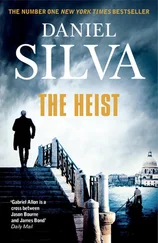“What was that?” she asked.
“Go back to sleep.”
“I saw a red light.”
“It was my radio.”
“Why are you listening to the radio at three in the morning?”
Before he could answer, the bedside lamp flared. Her eyes flashed across his dark clothing before settling on the silenced gun that was still in his hand. She opened her mouth to scream, but he placed his palm heavily across her face before any sound could escape. As she struggled to free herself from his grasp, he whispered soothingly into her ear. “Don’t worry, my love,” he was saying. “It will only hurt a little.”
Her eyes widened in terror. Then he twisted her head violently to the left, severing her spinal cord, and held her gently as she died.
It was not the custom of Reginald Ogilvy to stand the lonely hours of the middle watch, but concern for the safety of his famous passenger drove him to the bridge of the Aurora early that morning. He was checking the weather forecast on an onboard computer, a fresh cup of coffee in his hand, when the man called Colin Hernandez appeared at the top of the companionway, dressed entirely in black. Ogilvy looked up sharply and asked, “What are you doing here?” But he received no reply other than two rounds from the silenced Stechkin that pierced the front of his uniform and mauled his heart.
The coffee cup clattered loudly to the floor; Ogilvy, instantly dead, thudded heavily next to it. His killer moved calmly to the console, made a slight adjustment to the ship’s heading, and retreated down the companionway. The main deck was deserted, no other crew members on duty. He lowered one of the Zodiac dinghies into the black sea, clambered aboard, and released the line.
Adrift, he bobbed beneath a canopy of diamond-white stars, watching the Aurora slicing eastward toward the shipping lanes of the Atlantic, pilotless, a ghost ship. He checked the luminous face of his wristwatch. Then, when the dial read zero, he looked up again. Fifteen additional seconds elapsed, enough time for him to consider the remote possibility that the bomb was somehow defective. Finally, there was a flash on the horizon—the blinding white flash of the high explosive, followed by the orange-yellow of the secondary explosions and fire.
The sound was like the rumble of distant thunder. Afterward, there was only the sea beating against the side of the Zodiac, and the wind. With the press of a button, he fired the outboard and watched as the Aurora started her journey to the bottom. Then he turned the Zodiac to the west and opened the throttle.
THE FIRST INDICATION OF TROUBLE came when Pegasus Global Charters of Nassau reported that a routine message to one of its vessels, the 154-foot luxury motor yacht Aurora , had received no reply. The Pegasus operations center immediately requested assistance from all commercial ships and pleasure craft in the vicinity of the Leeward Islands, and within minutes the crew of a Liberian-registered oil tanker reported that they had seen an unusual flash of light in the area at approximately 3:45 that morning. Shortly thereafter the crew of a container ship spotted one of the Aurora ’s dinghies floating empty and adrift approximately one hundred miles south-southeast of Gustavia. Simultaneously, a private sailing vessel encountered life preservers and other floating debris a few miles to the west. Fearing the worst, Pegasus management phoned the British High Commission in Kingston and informed the honorary consul that the Aurora was missing and presumed lost. Management then sent along a copy of the passenger manifest, which included the given name of the former princess. “Tell me it isn’t her,” the honorary consul said incredulously, but Pegasus management confirmed that the passenger was indeed the former wife of the future king. The consul immediately rang his superiors at the Foreign Office in London, and the superiors determined the situation was of sufficient gravity to wake Prime Minister Jonathan Lancaster, at which point the crisis truly began.
The prime minister broke the news to the future king by telephone at half past one, but waited until nine to inform the British people and the world. Standing outside the black door of 10 Downing Street, his face grim, he recounted the facts as they were known at that time. The former wife of the future king had traveled to the Caribbean in the company of Simon Hastings-Clarke and two other longtime friends. On the holiday island of Saint Barthélemy, the party had boarded the luxury motor yacht Aurora for a planned one-week cruise. All contact with the vessel had been lost; surface debris had been discovered. “We hope and pray the princess will be found alive,” the prime minister said solemnly. “But we must prepare ourselves for the very worst.”
The first day of the search produced no remains or survivors. Nor did the second day or the third. After conferring with the Queen, Prime Minister Lancaster announced that his government was operating under the assumption that the beloved princess was dead. In the Caribbean, the search teams focused their efforts on finding wreckage rather than the bodies. It would not be a long search. In fact, just forty-eight hours later, an unmanned submersible operated by the French navy discovered the Aurora lying beneath two thousand feet of seawater. One expert who viewed the video images said it was clear the vessel had suffered some type of cataclysmic failure, almost certainly an explosion. “The question is,” he said, “was it an accident, or was it intentional?”

A majority of the country—reliable polling said it was so—refused to believe she was actually gone. They hung their hopes on the fact that only one of the Aurora ’s two Zodiac dinghies had been found. Surely, they argued, she was adrift on the open seas or had washed ashore on a deserted island. One disreputable Web site went so far as to report that she had been spotted on Montserrat. Another said she was living quietly by the sea in Dorset. Conspiracy theorists of every stripe concocted lurid tales of a plot to kill the princess that was conceived by the Queen’s Privy Council and carried out by Britain’s Secret Intelligence Service, better known as MI6. Pressure mounted on its chief, Graham Seymour, to issue a full-throated denial of the allegations, but he steadfastly refused. “These aren’t allegations ,” he told the foreign secretary during a tense meeting at the service’s vast riverfront headquarters. “These are fairy tales spun by people with mental disorders, and I won’t dignify them with a response.”
Privately, however, Seymour had already reached the conclusion that the explosion aboard the Aurora was not an accident. So, too, had his counterpart at the DGSE, the highly capable French intelligence service. A French analysis of the wreckage video had determined that the Aurora was blown apart by a bomb detonated belowdecks. But who had smuggled the device aboard the vessel? And who had primed the detonator? The DGSE’s prime suspect was the man who had been hired to replace the Aurora ’s missing head chef on the evening before the yacht left port. The French forwarded to MI6 a grainy video of his arrival at Gustavia’s airport, along with a few poor-quality still photos captured by private storefront security cameras. They showed a man who did not care to have his picture taken. “He doesn’t strike me as the sort of chap who would go down with the ship,” Seymour told a gathering of his senior staff. “He’s out there somewhere. Find out who he really is and where he’s hiding out, preferably before the Frogs.”
Читать дальше
